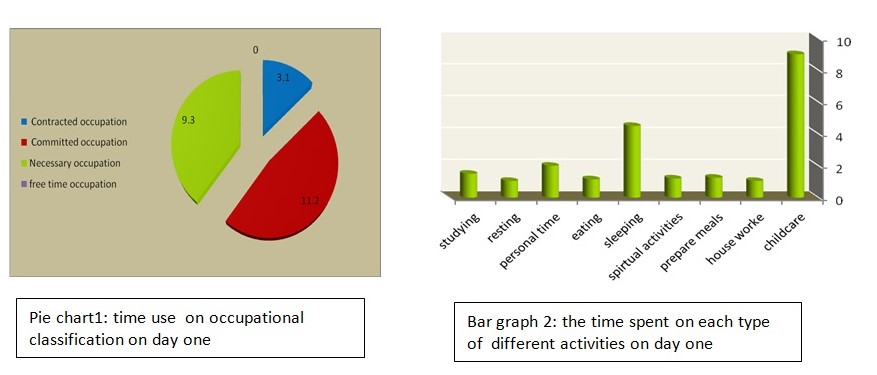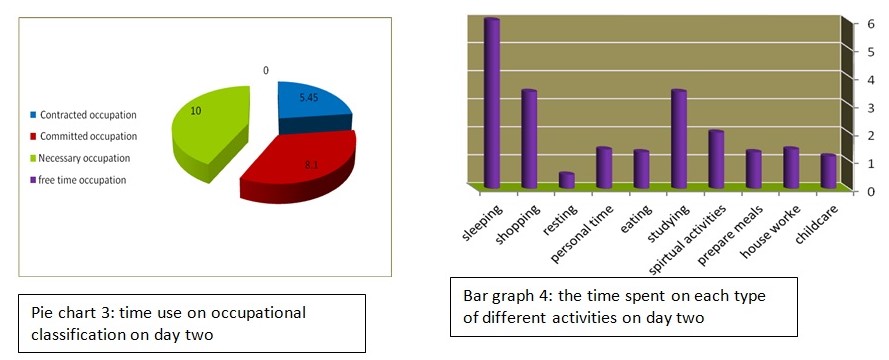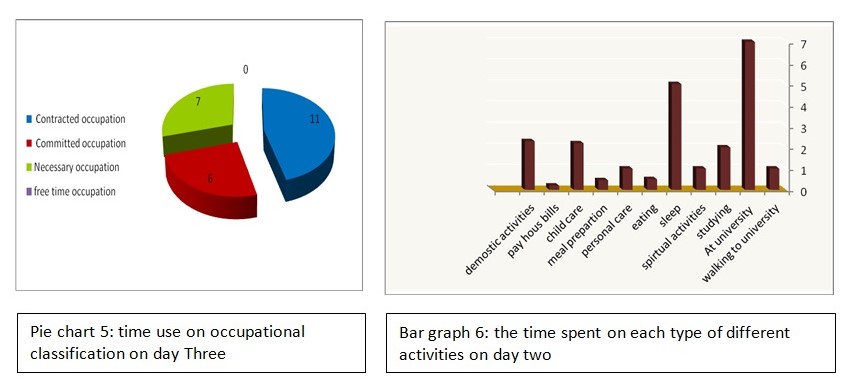Introduction
The study of human occupation is of great interest to many psychologists and sociologists. Since human occupations exist within a temporal context, studying how they are organized over time and used in daily life is a measurable way of understanding human participation and quality of life. Besides, it helps to identify whether the activities are restricted or constrained.
This field of research can explain many experiences of a person, their values, attitudes, or mental problems (Pierce, 2001). In this paper, my occupational engagement during three different days will be examined. Specifically, the essay will cover methods of recording and collecting the data, a summary of the key findings, and a discussion of how occupation is used over time. In addition, the paper will cover factors that influenced my time management and how occupational behaviour could affect my health and well-being.
Methods
In this investigation of my occupation, several techniques to collect and analyse relevant data have been used. In particular, the techniques applied are time-use diaries and questions that are provided by the occupational therapy department at the university, which are based on the Australian Bureau of statistics’ time-use survey conducted in the year 1997. These diaries were used as data-collection instruments to record three different days. In my diary, I recorded each of the primary activities, the secondary activities, and when it takes place. Later, I used this document to identify the trends in my occupational behaviour. The records were made on Wednesday, Saturday, and Monday. The measurements were taken after every five minutes for 24 hours each day. This selection was necessary for showing how my activities could change with time passing.
Additionally, I used the technique developed by Dagfinn Aas (1982) to categorize my daily occupations as they occurred. This researcher suggests that the time of a person can be divided into several categories such as contracted time, free time, committed time, and necessary time (Aas, 1982). It is important to note that contracted time is usually spent on compensated work or on the learning that takes place in formal educational institutions, such as colleges or universities (Addison, 2010, p. 97). This concept implies that there is an agreement according to which a person commits to dedicate some time to attain a specific objective (Addison, 2010, p. 97). For instance, one can highlight the contract signed by employees and employers. It is necessary to bear in mind that such actions of a person are not rewarded (Cristiansen & Townsend, 2011). At least, this individual does not receive any financial compensation.
Apart from the above, this classification includes a category such as the necessary time that a person needs to maintain his/her well-being as well as fitness. These activities are necessary to meet the physiological needs of an individual (Cristiansen & Townsend, 2011). For instance, a good time should be committed to activities such as sleeping, showering, and personal hygiene. They are critical for ensuring that an individual remains functional throughout the day. Finally, it is necessary to consider personal or free time. Researchers offer various examples of such personal occupations as hobbies or sports. Free time is often dedicated to tasks that promote people’s self-expression. They are supposed to make the individual’s experiences more fulfilling (Cristiansen &Townsend, 2011, p.105). Concerning my task, I will attempt to create an understanding of how my occupational engagement is structured by applying Dagfinn’s technique.
This conceptual framework is an essential tool for quantitatively describing occupational patterns. Moreover, this approach his holographically presents data. During each day, I recorded the number of hours dedicated to each activity. Thus, I could determine the portion of time devoted to various occupations. I also constructed pie charts and bar graphs that could illustrate my daily schedule.
I experienced some challenges such as difficulty in determining the category to which a particular activity could belong. In particular, I would refer to spiritual activities, which were neither required for supporting the family nor had any financial or material rewards. Nevertheless, I am firmly convinced that spiritual activity such as praying is motivated by the internal sense of duty that guides the behaviour of a person. In my opinion, it should belong to contractual time as it can be performed in fixed time besides functioning as the core of being and essence of existence. In part, this perception can be explained by my upbringing and cultural background. Also, some activities were difficult to decide as being primary or secondary. For instance, using Facebook as part of my learning activities where I had to contact our tutorial group and post my research about my learning objective. At the same time, I was chatting with friends as social communication using the same Facebook page.
Findings
The visual data sets below are representing the result of this survey and show how my time was structured during these three days.
Day One

Pie chart 1, demonstrates that the committed occupation in “day one” (Wednesday) is the most significant. I spent over 11 hours on committing time with only 3 hours on contracting time. Bar graph 2 above compares the number of hours spent among the nine types of my occupations on day one. Childcare activity was ranked at the top with around 9 hours followed by sleeping for approximately 4 hours, which are part of the necessary time. The remaining activities (educational, spiritual, personal, meal preparation, eating, and housework) took an average of 1 to 2 hours for each occupation.
Day Two

Pie chart 3 above shows that on weekends, I spend more time on the necessary and committed occupations totalling about 10 and 8 hours respectively. Graph four clearly illustrates that 6 hours were used to compensate for the necessary sleeping time with four hours being allocated for shopping and bringing the family needs for the following week. Besides, the almost evenly weighted hours for the remaining activities, around three and a half hours, were spent on self-studying.
Day Three

Monday, a typical day for my time distribution, was on the third day. Monday was depicted in pie chart 5 and bar graph 6. Most of the time (11 hours) was dedicated to contracted time activities such as commuting, attending lectures and self-learning. The committed and necessary time were split almost evenly within the 24 hours timeline.
Overall, the analysis of the collected data suggests that there are some patterns in my use of time. In particular, my personal or free time is reduced to the minimum. During each day, I had no opportunity to focus on my favourite pastimes. Therefore, I did not include this component in the pie diagram. If this trend persists for a long time, my experiences may be impaired significantly. This risk is discussed by various researchers who examine occupational behaviour from a therapeutic viewpoint (Hocking & Wright, 2011). In their opinion, personal occupations can make an individual less vulnerable to stress and hardships (Hocking & Wright, 2011). Indeed, my studies can bring some satisfaction by helping me to display my creative skills. Nevertheless, personal occupations lack a significant attribute of personal time since they are not voluntarily. This is a limitation that should be taken into account.
Discussion
Researchers note that a person should be able to construct his/her occupation (Pierce, 2001, p. 138). In many cases, individuals must adjust their behaviour to the impact of the external environment. For instance, people should comply with the requirements that can be set by employers or educators. Additionally, it is necessary to remember some internal problems that can affect the activities of a person. Very often, the impact of these forces is rather unpredictable. For instance, the illness of my son profoundly affected my occupational behaviour. I needed to set aside every other activity. To a large degree, this event prompted me to think about the mothers who continuously have to deal with such problems.
Additionally, individuals should have some free time. It is crucial for the personal fulfilment of a person. Unfortunately, due to various circumstances, people may not have any recreational opportunities. In turn, researchers note that one should find the so-called occupational balance (Cristiansen & Townsend, 2011, p. 48). This equilibrium is required for meeting the physical, mental needs, and social needs (Cristiansen & Townsend, 2011, p. 48). In contrast, its absence can lead to a sense of dissatisfaction or even frustration. This issue is of great concern to counsellors who believe that occupational therapy can help a person overcome many emotional disorders such as depression or anxiety (Hocking & Wright, 2011, p. 29).
Apart from that, the course readings reminded me that the cultural background of a person can affect his/her occupational behaviour (Hinojosa & Blount, 2009, p. 123). For example, religion has always played a significant role in my family. Therefore, it is an indispensable part of my everyday life. Moreover, I am not willing to remove this activity from the list of my contractual occupations. In my view, it is essential for my emotional and social well-being.
My daily activities are considerably shaped by different obligations and commitments. As far as the first day is concerned, my routine was dramatically affected by the disease of my son. So, I needed to ensure that nothing could pose a threat to his life. In turn, I spent more than eleven hours on committed occupations such as childcare. It should be noted that many women face such difficulties. These issues are particularly relevant to mothers who have a child with a disability (Crowe & Florez, 2006, p. 194). Sometimes, these people have to struggle with stress and burnout. As a rule, I am not an authoritarian or controlling parent. In my view, this parenting style can deprive a child of his/her self-sufficiency (Armstrong, Ogg, Sundman-Wheat, & Walsh, 2014). However, under such circumstances, I had to take every possible precaution to safeguard the health of my son.
Interestingly, the first day can be viewed as an exception. On Saturday, I could dedicate more time to necessary occupations such as sleeping and resting. I could focus more on my contractual activities like studying. Nevertheless, one should keep in mind that it was a weekend day. In my view, Monday represents a more typical distribution of my time. In particular, I needed to spend 11 hours attending lectures and self-directed studies. The rest of the day was devoted to committed occupations such as childcare and meal preparation. I am more accustomed to this schedule because it enables me to establish a balance between my studies and family duties.
In my opinion, I must improve my time management. This task can help me increase my time. An individual can better achieve this goal if he/she applies occupational analysis. This method can help identify those activities that take too much time. Later, one should uncover the origins of this deficiency and eliminate them. Overall, this strategy can enable me to reconcile the roles of a student and the duties of a mother. Currently, it is one of my top priorities for me. In part, this task becomes more difficult because I am an international student. Furthermore, my command of the English language is not very good. Therefore, I need to spend more time on learning activities. Under such circumstances, the adverse effects of information overload also become more noticeable. It is one of the risks that should not be overlooked.
Moreover, I would be willing to learn more about the time management practices adopted by female students who have a child. In my opinion, this knowledge can help me better cope with various challenges. Furthermore, this assignment has prompted me to learn more about the guidelines that researchers and counsellors can offer to people who want to improve their occupational behaviour. It seems that such recommendations can empower an individual.
This task has been of great value to me because I could better see how I allocate my time. Very often, this allocation is not efficient. Additionally, this assignment has been rather useful because I could learn more about the peculiarities of time-use research. This field of study helps show why people can struggle with different psychological problems (Mackenzie & O’Toole, 2011). Admittedly, three days may not be sufficient for making generalised conclusions about my occupational behaviour. It is necessary to examine a larger sample to get better insights into my time management. However, the collected data should not be overlooked because it can help me improve my current lifestyle.
Conclusion
In summary, human occupation is a very complex concept that has the potential of constructing an individual’s life and sense of self. The role of occupation in human experience is best understood through measuring classification schemes and time used. The report has highlighted my occupational engagement for three days, that is, on Wednesday, Saturday, and Monday. The analysis indicated that significant variations are caused by different contractual obligations and commitments. In some cases, my occupational engagement was beyond my control or planning.
Generally, this task helped me to understand the peculiarities of my use of time. It was dominated by contractual and commitment occupations such as childcare, housework, and learning activities. Therefore, this task has clarified the necessity of having a balance in the time between personal occupations for the well-being of an individual. This assignment has provided me with a great insight into time used as a valuable tool in analysing daily activities. This insight will enable me in the future, as an occupational therapist, to evaluate the temporal behaviour of the clients to identify the temporal dysfunction and make an appropriate intervention and temporal adoption.
References
Aas, D. (1982). Designs for large scale time-use studies of the 24 hour day. Sofia, Bulgaria: Research Group on-time budgets and social activities.
Addison, H. (2010).Feminist Economics. New York, NY: Lulu.
Armstrong, K., Ogg, J., Sundman-Wheat, A., & Walsh, J. (2014). Evidence-Based Interventions for Children with Challenging Behavior. New York, NY: Springer.
Cristiansen, C., & Townsend, E. (2011). Introduction to occupation: the art and science of living; new multidisciplinary perspectives for understanding human occupation as a central feature of individual experience and social organization. New York, NY: Pearson Education.
Crowe, T., & Florez, S. (2006). Time use of mothers with school-age-children: a continuing impact of a child’s disability. American Journal of Occupational Therapy, 60(20), 194-203.
Hinojosa, J., & Blount, J. (2009). The texture of life: Purposeful activities in the context of occupation. New York, NY: AOTA Press.
Hocking, C., & Wright, V. (2011). Occupational science: Adding value to occupational therapy. New Zealand Journal of Occupational Therapy, 58(1), 29-35.
Mackenzie, L., & O’Toole, G. (2011). Occupational analysis in practice. New York, NY: Wiley-Blackwell.
Pierce, D. (2001). Untangling occupation and activity. American Journal of Occupational Therapy, 55(2), 138-146.